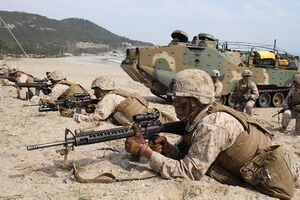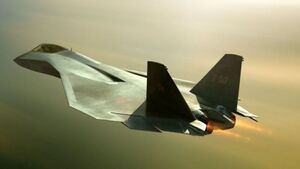Emmeria
This article is incomplete because it is pending further input from participants, or it is a work-in-progress by one author. Please comment on this article's talk page to share your input, comments and questions. Note: To contribute to this article, you may need to seek help from the author(s) of this page. |
United Kingdom of Emmeria Emmeria | |
|---|---|
|
Flag | |
Anthem: God Save the Queen | |
| Capital and | New Avalon |
| Recognised national languages | Emmerian |
| Recognised regional languages | Cambric, Gaelic, Lower Caledon, Nordenian, several others |
| Government | Federal parliamentary constitutional monarchy |
• Head of State | Queen Catherine IV (1990~) |
• Prime Minister | Gerald Morgan (2015~) |
• Chief Justice | Joseph Long (2003~) |
| Legislature | Parliament of Emmeria |
| House of Lords | |
| House of Commons | |
| Area | |
• Total | 8,404,806 km2 (3,245,114 sq mi) |
• Water (%) | 8.7 |
| Population | |
• 2019 estimate | 154,111,657 (6th) |
• 2015 census | 152,672,324 |
• Density | 18.34/km2 (47.5/sq mi) (68th) |
| GDP (PPP) | 2019 estimate |
• Total | $9.208 trillion (OFD) (4th) |
• Per capita | $59,752 (OFD) |
| GDP (nominal) | 2018 estimate |
• Total | $8.296 trillion (OFD) (3rd) |
• Per capita | $53,830 (OFD) |
| Gini (2017) | 0.311 low |
| HDI (2017) | 0.946 very high · 2nd |
| Currency | Pound Sterling (ERP) |
| Time zone | UTC-9 to -4 |
• Summer (DST) | UTC-8 to -3 |
| Calling code | +83 |
The United Kingdom of Emmeria, or simply Emmeria, is a country in the continent of Anea to the west of Estovakia and the southeast of Nordennavic. It is 8,404,806 square kilometers in area, and over 154 million people reside in mainland Suevia and the island territories. The capital city, New Avalon, is in the southeast of the country and has over 11 million residents.
Since its founding, Emmeria has been a major player in Altereal affairs. As one of the most populous and developed nations in the world, it has great economic, diplomatic, cultural and military influence. It is a member of the Commonwealth of Nations, the G7, the G15 and the IUN Security Council (as a permanent member) among other organizations.
History
Prehistoric/Classical
Medieval/Early Modern Era
The Age of Conflict
Union
Early Union Era
Consolidation and Expansion
Industrial Development
First Anean War and Reconstruction
Enfranchisement
First Global War (1915~1920)
The Anean Front
War at Sea
The Emmerian Expeditionary Force
Interwar Era
Aftershocks of the First Global War
The Estovakian Revolution
The Decade of Prosperity
The Great Depression
Second Global War (1938~1945)
Border Tensions
Battle of the Ceres Sea
Modern Age (1946~)
Beginning of the Cold War (1946~1952)
The Second Anean War (1953~1954)
The Arms Race (1955~1983)
The Third Anean War (1984)
The Estovakian Civil War (1985~1992)
The Detente Era (1995~)
Geography
Climate
Environment
Politics and Government
Administrative Divisions
The United Kingdom of Emmeria is divided into 4 countries (Albion, Alba, Cambria and Hibernia), which are subdivided into regions. Each country has power over most internal affairs, but defense, foreign affairs and other federal tasks are carried out by the central government in New Avalon.
The Country of Albion consists of 9 regions, which are subdivided into counties. The First Minister of Albion and the Albion Parliament are based in New Avalon. As the most populous country (119,229,600 people in 2019), and the seat of the federal government, Avalon has historically played a leading role in the Federation. The country sends 479 MPs to the Parliament of Emmeria.
The Country of Alba consists of 3 regions, which are divided into shires. The First Minister of Alba and the Alban Parliament are based in Strathclyde. The state had a population of 11,629,000 people in 2019, and sends 53 MPs to the Parliament of Emmeria.
The Country of Cambria consists of 1 region, which is divided into principal areas. The First Minister of Cambria and Cambrian National Assembly are based in Bridgeport. The state had a population of 6,699,000 in 2019, and sends 36 MPs to the Parliament of Emmeria.
The Country of Hibernia consists of 4 regions, which are divided into counties. The First Minister of Hibernia and Hibernian Assembly are based in Dalway. The state had a population of 14,089,800 people in 2018, and sends 68 MPs to the Federal Parliament.
Each parliamentary constituency receives a seat in the House of Commons. There are a total of 636 constituency seats in the House of Commons. Members of the House of Lords are appointed to their positions.
Each county can be further divided into various boroughs and districts.
| Region Name | Capital | Population | House of Commons Seats |
|---|---|---|---|
| 32,608,000 | 79 | ||
| 24,989,000 | 59 | ||
| 15,426,000 | 37 | ||
| 3,565,000 | 9 | ||
| 12,890,000 | 31 | ||
| 8,869,000 | 21 | ||
| 10,249,000 | 25 | ||
| 3,713,000 | 9 | ||
| 4,347,000 | 11 | ||
| 9,765,000 | 24 | ||
| 3,705,000 | 9 | ||
| 9,766,000 | 24 | ||
| 3,611,000 | 9 | ||
| 3,537,000 | 9 | ||
| 1,368,000 | 3 | ||
| 2,267,000 | 6 | ||
| 2,128,000 | 5 | ||
| 289,000 | 1 |
Foreign Relations
Military
Main Article: Emmerian Armed Forces
The Emmerian Armed Forces are tasked with defending the United Kingdom of Emmeria from foreign threats and aggression, while also contributing to peacekeeping, humanitarian and disaster-relief efforts. The armed forces consist of three main service branches: the Emmerian Army, Royal Emmerian Navy (REN) and Royal Emmerian Air Force (REAF). Two sub-branches, the Royal Emmerian Marines and Royal Emmerian Coast Guard (RECG), are independent but nominally under Navy control.
Since its foundation, its principal adversary has been the Estovakian Imperial Armed Forces (1718~1921), and its successors the People's Army of Estovakia (1921~1991) and the Estovakian Armed Forces (1991~present). The presence of such a large ground force on its northern border and the presence of Yuktobania to the south has forced the Emmerian Armed Forces to retain conscription (with alternate service options) to this day. Most conscripts serve for at least 3 years in the reserve forces, with some opting for a shorter and continuous active-duty service period.
In 2019 the United Kingdom of Emmeria spent a total of $277.2 billion on defense, equivalent to 3.34% of GDP. Emmeria has 798,800 active military personnel and 1,373,200 reserve personnel. Due to consistent investment in training, equipment and technology, along with the world's second largest economy and third largest defense budget, Emmeria possesses one of the most powerful armed forces in Altereal.
Emmerian Army
"Guardian of the Nation"
Main Article: Emmerian Army
The Emmerian Army (established in 1540) is the largest branch of the Emmerian Armed Forces, with 503,000 active and 1,273,900 reserve personnel. It has the highest percentage of conscripts out of all the major branches, especially in (reserve) light infantry formations. However it retains a highly trained and experienced cadre of commissioned and non-commissioned officers, along with various specialized units.
The army operates 3,150 tanks, 9,913 armored fighting vehicles, over 5,500 artillery pieces and 1,431 helicopters. Its personnel and equipment are organised into four field armies, which are divided into corps, divisions and brigades. There are a total of 23 active division (8 armored, 5 mechanized, 2 mountain, 1 airborne and 1 air assault) and 9 reserve force commands (with brigades, regiments and district defense commands), which assume the role of divisions in wartime. 6 active and 5 reserve combat aviation brigades support land forces at the corps level.
Around half of the army's forces are deployed near the border with Estovakia, to counter the extensive deployment of Estovakian land units in the region.
See also: Equipment of the Emmerian Army, Organization of the Emmerian Army
"We Rule the Waves"
Main Article: Royal Emmerian Navy (REN)
The Royal Emmerian Navy (established in 1546) is the third-largest branch of the Emmerian Armed Forces, with 157,400 active and 49,500 reserve personnel. It operates 4 carriers, 52 major surface combatants (frigate-size or larger), 115 minor combatants (corvette-size or lower), 12 amphibious warfare ships, 28 nuclear submarines and 23 conventional submarines. It also operates 915 fixed-wing, rotary-wing and unmanned aircraft.
The REN operates out of several naval bases, including the five home bases, and various bases in the island territories and overseas.
See also: Commissioned Warships of the Royal Emmerian Navy, Organization of the Royal Emmerian Navy
Royal Emmerian Marines (REM)
"Leading the Way"
Main Article: Royal Emmerian Marines (REM)
The Royal Emmerian Marines (established in 1664) is the amphibious warfare force of the Emmerian Armed Forces, with 49,400 active and 16,000 reserve personnel. As the second largest marine force in the world, it is organized into 2 Marine Expeditionary Forces and 3 security battalions, deployed in the marine sectors of REN naval bases. While nominally independent, it closely cooperates with, and in wartime is commanded by, the Royal Emmerian Navy.
Royal Emmerian Marines training and doctrine is similar to that of the OMC, focusing on physical and mental fitness, the ability to achieve objectives in small groups, and potential operations on foreign shores. Along with airborne and special forces, the is usually the first ground force to be deployed for foreign interventions.
The REM operates similar land equipment to the Emmerian Army, and also operates various fixed-wing, tilt-rotor and rotary-wing aircraft. REM troop contingents protect ports and embark on REN amphibious warfare ships, and REM pilots operate from both Naval Air Stations and the decks of amphibious assault ships or aircraft carriers.
See also: Equipment of the Royal Emmerian Marines
Royal Emmerian Air Force (REAF)
"Soaring High and True"
Main Article: Royal Emmerian Air Force (REAF)
The Royal Emmerian Air Force (established 1918) is the second-largest branch of the Emmerian Armed Forces, with 235,600 active and 95,400 reserve personnel. It operates 1,037 fighters, 146 attack aircraft, 52 bombers, 361 transports, 81 helicopters, 627 trainers, 205 support aircraft and 591 unmanned aircraft. The REAF is one of the largest and most technologically advanced air forces in the world, and a world leader in stealth aircraft and manned-unmanned aircraft networking. It also maintains a significant orbital presence (with navigation, reconnaissance/surveillance and communication satellites), and works with various Emmerian aerospace firms on military projects.
See also: List of active Emmerian military aircraft, Organization of the Royal Emmerian Air Force
Economy
Main Article: Economy of Emmeria
Energy
Energy Resources
- Crude Oil Production: 1,513,000 barrels per day (33.1% of consumption)
- Refined Petroleum Products Production: 4,130,000 barrels per day
- Refined Petroleum Products Consumption: 4,583,000 barrels per day
- Proven Oil Reserves: 7,503,000,000 barrels
- Strategic Oil Reserves: 726,700,000 barrels (158.5 days worth of consumption)
- Natural Gas Production: 81,860,000,000 cubic meters per year (48.7% of consumption)
- Natural Gas Consumption: 167,900,000,000 cubic meters per year
- Proven Natural Gas Reserves: 1,609,000,000,000 cubic meters
- Coal Production: 241,100,000 tons per year (99.1% of consumption)
- Coal Consumption: 243,400,000 tons per year
- Proven Coal Reserves: 29,650,000,000 tons
- Uranium Production: 770 tons per year (13.7% of consumption)
- Uranium Consumption: 5,631 tons per year
- Uranium Reserves: 105,700 tons
- Iron Ore Production: 32,270,000 tons per year
- Steel Production: 83,480,000 tons per year
Energy Production/Usage
- Per capita Electricity Usage: 6,642 kWh per person per year
- Total Electricity Usage: 1,023,600,000,000 kWh per year
Electricity Sources
- Renewable: 29.2% (10.4% Wind, 7.7% Solar, 6.5% Hydro-power, 4.6% Other)
- Natural Gas: 27.9%
- Nuclear: 24.1%
- Coal/Oil: 18.8%
- Total CO2 Emissions: 1,294,540 tons per year
- CO2 Emissions per capita: 8.4 tons per year




